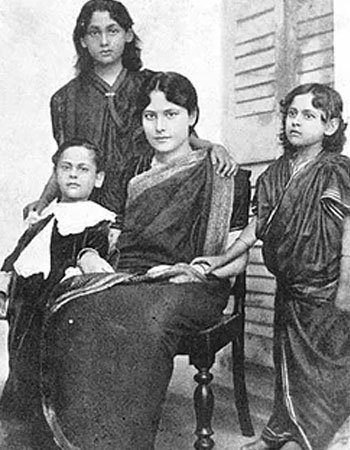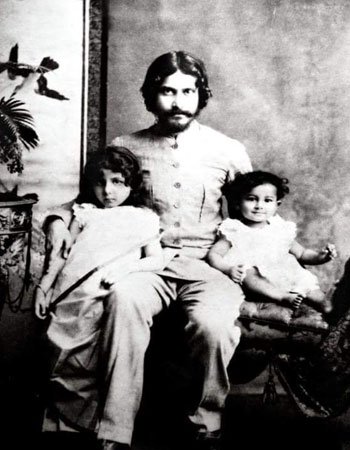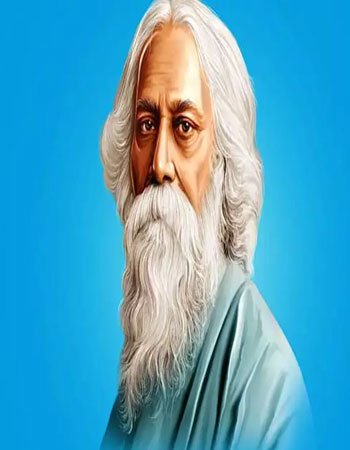Rabindranath Tagore, also known as Bengali Rabīndranāth Ṭhākur, was born on May 7, 1861, in Calcutta (now Kolkata), India. His age is 80 years old.He was a multifaceted personality, excelling as a poet, writer, playwright, composer, philosopher, social reformer, and painter. While he received his education at home, he was sent to England for formal schooling when he turned seventeen, although he didn’t complete his studies there.
Rabindranath Tagore Biography, Age, Wife, Family and More
During his later years, alongside his diverse literary endeavors, Rabindranath Tagore took on the responsibility of managing the family estates. This involvement brought him closer to the lives of ordinary people and fueled his passion for social reforms. Affectionately referred to as Gurudev, Kabiguru, and Biswakabi, his songs became widely popular and came to be known as Rabindrasangeet.
Rabindranath Tagore Family
Rabindranath Tagore’s father purchased a vast tract of land for contemplation purposes and named it Santiniketan. Due to the early loss of his mother and his father’s frequent travels; he was primarily cared for by servants and maids during his upbringing. His grandfather, Dwarkanath Tagore, was a wealthy landlord and a champion of social reform. Additionally, his sister, Swarnakumari, pursued a career as a novelist. Among his siblings, Rabindranath Tagore was the youngest son, part of a family of thirteen children.

Rabindranath Tagore Father Pic

Rabindranath Tagore Sister and Brother Pic

Rabindranath Tagore Wife Pic

Rabindranath Tagore Son Pic

Rabindranath Tagore Childhood Pic
Education
Rabindranath Tagore’s formal education commenced in Brighton, East Sussex, England, he attended a public school. Subsequently, he gained admission to the University College of London, where he embarked on legal studies as per the requirements. During his time there, he also delved into the rich literature and music traditions of England, Ireland, and Scotland. Upon returning to India, Tagore tied the knot with Mrinalini Devi.
Wife and children
Rabindranath Tagore was indeed married to Mrinalini Devi. Together, they had five children.
Rabindranath Tagore Died
He passed away on August 7, 1941, at the age of 80, in Calcutta, Bengal Presidency, which was then under British rule in India.
The early life of Rabindranath Tagore
Born on May 7, 1861, in Calcutta, Rabindranath Tagore was the youngest son of Debendranath Tagore and Sarada Devi. He not only made significant contributions as a poet, writer, and philosopher but also played a pivotal role as a cultural reformer. He challenged the boundaries that confined Bengali art to classical Indian forms, bringing about modifications that revitalized it. Tagore hailed from a family with a notable social reformer as his grandfather, Dwarkanath Tagore, who was also a wealthy landlord.
Establishment of Santiniketan
Rabindranath Tagore’s father, Debendranath Tagore, acquired a large expanse of land in Santiniketan. In 1863, Debendranath Tagore established an ‘Ashram’ on that land. Later, in 1901, Rabindranath Tagore himself founded an open-air school within the premises. This school, known as ‘The Mandir,’ featured a prayer hall with marble flooring. It was also referred to as ‘Patha Bhavana’ and initially had just five students.
Literary Works
During his teenage years, Rabindranath Tagore began to craft short stories. While he had already embarked on his writing journey at a young age, his desire to create a greater volume of literary works grew stronger after the tragic loss of his wife and children. Among his extensive collection of stories, several have gained significant acclaim. Some of his most renowned short stories include “Kabuliwala,” “Kshudita Pashan,” “Atottju,” “Haimanti,” and “Musalmanir Golpo,” among many others.
Awards & Achievements
November 14, 1913, marked a momentous occasion for Rabindranath Tagore as he was awarded the prestigious Nobel Prize in Literature. This recognition was a testament to his extraordinary and revolutionary contributions to the world of literature. Tagore’s literary genius reshaped the landscape of Bengali literature and propelled it into new realms.
Growing Years and Career
Rabindranath Tagore, affectionately known as Gurudev, Kabiguru, and Biswakabi, displayed remarkable literary talent from a young age. At the tender age of eight, he wrote his first poem, setting the stage for his extraordinary literary journey. In the late 19th and early 20th centuries, Tagore reshaped Bengali literature, music, and Indian art through his innovative approach known as Contextual Modernism. While Tagore received his education at home, he was sent to England for formal schooling when he turned seventeen. However, he did not complete his studies there. Despite this, his thirst for knowledge and his passion for literature remained undeterred. By the age of sixteen, one of Tagore’s short stories titled “Bhanusimha” was published, showcasing his burgeoning talent as a writer.
Original poetry in Bengali |
|||||||||||
| Bengali title | Transliterated title | Translated title | Year | ||||||||
| ভানুসিংহ ঠাকুরের পদাবলী | Bhānusiṃha Ṭhākurer Paḍāvalī | Songs of Bhānusiṃha Ṭhākur | 1884 | ||||||||
| মানসী | Manasi | The Ideal One | 1890 | ||||||||
| সোনার তরী | Sonar Tari | The Golden Boat | 1894 | ||||||||
| গীতাঞ্জলি | Gitanjali | Song Offerings | 1910 | ||||||||
| গীতিমাল্য | Gitimalya | Wreath of Songs | 1914 | ||||||||
| বলাকা | Balaka | The Flight of Cranes | 1916 | ||||||||
Original dramas in Bengali |
|||||||||||
| Bengali title | Transliterated title | Translated title | Year | ||||||||
| বাল্মিকী প্রতিভা | Valmiki-Pratibha | The Genius of Valmiki | 1881 | ||||||||
| কালমৃগয়া | Kal-Mrigaya | The Fatal Hunt | 1882 | ||||||||
| মায়ার খেলা | Mayar Khela | The Play of Illusions | 1888 | ||||||||
| বিসর্জন | Visarjan | The Sacrifice | 1890 | ||||||||
| চিত্রাঙ্গদা | Chitrangada | Chitrangada | 1892 | ||||||||
| রাজা | Raja | The King of the Dark Chamber | 1910 | ||||||||
| ডাকঘর | Dak Ghar | The Post Office | 1912 | ||||||||
| অচলায়তন | Achalayatan | The Immovable | 1912 | ||||||||
| মুক্তধারা | Muktadhara | The Waterfall | 1922 | ||||||||
| রক্তকরবী | Raktakarabi | Red Oleanders | 1926 | ||||||||
| চণ্ডালিকা | Chandalika | The Untouchable Girl | 1933 | ||||||||
Original fiction in Bengali |
|||||||||||
| Bengali title | Transliterated title | Translated title | Year | ||||||||
| নষ্টনীড় | Nastanirh | The Broken Nest | 1901 | ||||||||
| গোরা | Gora | Fair-Faced | 1910 | ||||||||
| ঘরে বাইরে | Ghare Baire | The Home and the World | 1916 | ||||||||
| যোগাযোগ | Yogayog | Crosscurrents | 1929 | ||||||||
Original nonfiction in Bengali |
|||||||||||
| Bengali title | Transliterated title | Translated title | Year | ||||||||
| জীবনস্মৃতি | Jivansmriti | My Reminiscences | 1912 | ||||||||
| ছেলেবেলা | Chhelebela | My Boyhood Days | 1940 | ||||||||
Works in English |
|||||||||||
| Title | Year | ||||||||||
| Thought Relics | 1921 | ||||||||||
Translated
English translations |
|
| Year | Work |
| 1914 | Chitra |
| 1922 | Creative Unity |
| 1913 | The Crescent Moon |
| 1917 | The Cycle of Spring |
| 1928 | Fireflies |
| 1916 | Fruit-Gathering |
| 1916 | The Fugitive |
| 1913 | The Gardener |
| 1912 | Gitanjali: Song Offerings |
| 1920 | Glimpses of Bengal |
| 1921 | The Home and the World |
| 1916 | The Hungry Stones |
| 1991 | I Won’t Let you Go: Selected Poems |
| 1914 | The King of the Dark Chamber |
| 2012 | Letters from an Expatriate in Europe |
| 2003 | The Lover of God |
| 1918 | Mashi |
| 1928 | My Boyhood Days |
| 1917 | My Reminiscences |
| 1917 | Nationalism |
| 1914 | The Post Office |
| 1913 | Sadhana: The Realisation of Life |
| 1997 | Selected Letters |
| 1994 | Selected Poems |
| 1991 | Selected Short Stories |
| 1915 | Songs of Kabir |
| 1916 | The Spirit of Japan |
| 1918 | Stories from Tagore |
| 1916 | Stray Birds |
| 1913 | Vocation |
| 1921 | The Wreck |
Net Worth
| Net Worth | $1 million and $5 million dollars |
Rabindranath Tagore and His Last Days
Rabindranath Tagore’s final years were marked by immense suffering as he battled through two prolonged illnesses. The place he held closest to his heart, his childhood home in Jorasanko, became the setting for the last four years of his life. In 1937, he slipped into a comatose state, which recurred after three years. Despite enduring an extended period of pain, Tagore remained in his beloved Jorasanko home.
Favorite
| Color | Red Black |
| Food | vegetables |
| Drink | Tea |
| Actor/Actress | Primarily |
| Songs | Ei Kathati Mone Rekho |
| Movies | Geet Gaata Chal |
| Hobbies | Future Prediction |
Check Also: Chris Gayle
| Body Measurements | Chest: 44 |
| Birth Place | Calcutta, British India |
| Children | 5 |
| Eye Color | Black |
| Hair Color | White |
| Height In CM | 172 CM |
| Height In Meter | 1.72m M |
| Nationality | India |
| Parents | Father : Debendranath Tagore Mother : Sarada Devi |
| Profession | Writer, song composer, playwright, essayist, painter |
| Siblings | Brothers: N/A Sister: N/A |
| Spous | Mrinalini Devi |
| Weight | N/A |
| Zodiac Sign | Taurus |
Comments
If you have any question, please write below.

Enter your comment!